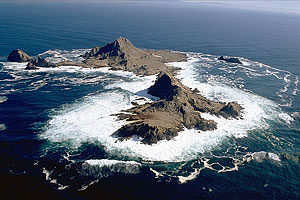 The Farallones consist of a group of rocky islands that are 28 miles North of San Francisco Bay.A national wildlife refuge just outside the San Francisco Bay is now under surveillance! The California Academy of Sciences in partnership with U.S. Fish and Wildlife and PRBO Conservation Science has installed a web camera on the Farallon Islands.
The Farallones consist of a group of rocky islands that are 28 miles North of San Francisco Bay.A national wildlife refuge just outside the San Francisco Bay is now under surveillance! The California Academy of Sciences in partnership with U.S. Fish and Wildlife and PRBO Conservation Science has installed a web camera on the Farallon Islands.
The Northern Farallones were originally granted protection by President Teddy Roosevelt in 1909. However, these islands were not always protected. Human consumption decimated many populations, some never to return. The demand for fur, oil and meat devastated the elephant and fur seal population. By 1900, the robust Common Murre population dwindled down to a few thousand because of the demand for Murre eggs.
Today, the Islands are further protected under the Marine Life Protection Act and the Farallones are also deemed a state marine conservation area. The majority of visitors of the human persuasion are not allowed access to the islands as they would upset the balance of the largest seabird breeding colony in the United States. Those humans that do frequent the island include wildlife biologists and land managers who are conducting wildlife research.
PRBO Conversation Science has been a local on the island day and night conducting research and monitoring the natives. The webcam helps their cause by collecting scientific data from a remote location. The camera enables biologists to observe without disturbing wildlife or incurring adverse environmental impact.
The water surrounding the islands makes this an ideal stomping ground for marine life and seabirds alike. Coastal upwelling takes place in the spring around the islands. The Coriolis Effect along the coast drives surface waters away from the coast; this water is then replaced with the denser waters from below. Within the deeper waters is a wealth of nutrients that are photosynthesized into dense blooms of plant plankton when exposed to the sun. This energizes the marine food chain as the plant plankton is eaten by krill. Krill is then made available to eat for fish, birds, and marine mammals. It does not only feed surrounding wildlife but growing human populations as well. The most productive fisheries in the world are supported by coastal upwelling. Given the location and the diversity of wildlife, the Farallones is well worth protecting.
